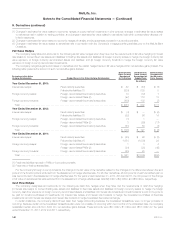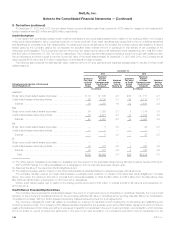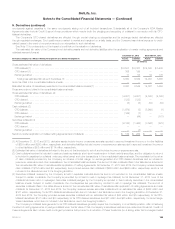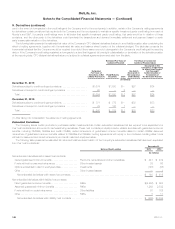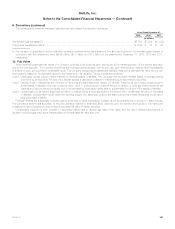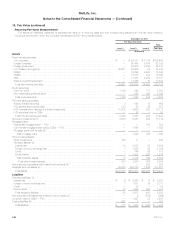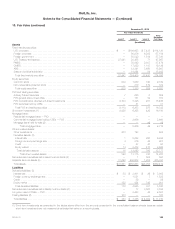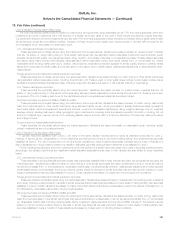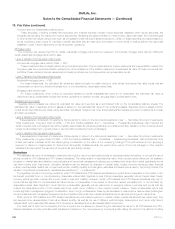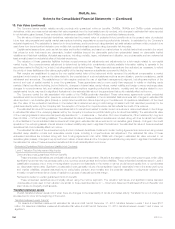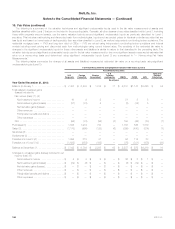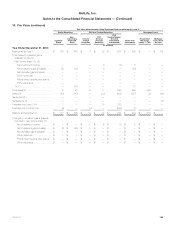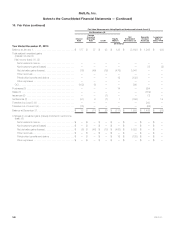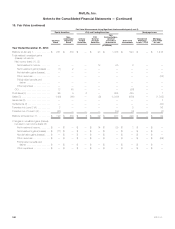MetLife 2013 Annual Report Download - page 160
Download and view the complete annual report
Please find page 160 of the 2013 MetLife annual report below. You can navigate through the pages in the report by either clicking on the pages listed below, or by using the keyword search tool below to find specific information within the annual report.
MetLife, Inc.
Notes to the Consolidated Financial Statements — (Continued)
10. Fair Value (continued)
Common and non-redeemable preferred stock
These securities, including privately-held securities and financial services industry hybrid securities classified within equity securities, are
principally valued using the market and income approaches. Valuations are based primarily on matrix pricing, discounted cash flow methodologies
or other similar techniques using inputs such as comparable credit rating and issuance structure. Certain of these securities are valued based on
inputs including quoted prices for identical or similar securities that are less liquid and based on lower levels of trading activity than securities
classified in Level 2 and independent non-binding broker quotations.
Mortgage Loans
The Company has elected the FVO for certain residential mortgage loans held-for-investment, commercial mortgage loans held by CSEs and
certain residential mortgage loans held-for-sale.
Level 2 Valuation Techniques and Key Inputs:
Commercial mortgage loans held by CSEs — FVO
These investments are principally valued using the market approach. The principal market for these investments is the securitization market. The
Company uses the quoted securitization market price of the obligations of the CSEs to determine the estimated fair value of these commercial loan
portfolios. These market prices are determined principally by independent pricing services using observable inputs.
Level 3 Valuation Techniques and Key Inputs:
Residential mortgage loans — FVO
For these investments, the estimated fair values are based primarily on matrix pricing or other similar techniques that utilize inputs that are
unobservable or cannot be derived principally from, or corroborated by, observable market data.
Mortgage loans held-for-sale
For these investments, when pricing for securities backed by similar adjustable-rate loans is not observable, the estimated fair value is
determined using unobservable independent broker quotations or valuation models using significant unobservable inputs.
Separate Account Assets
Separate account assets are carried at estimated fair value and reported as a summarized total on the consolidated balance sheets. The
estimated fair value of separate account assets is based on the estimated fair value of the underlying assets. Separate account assets include:
mutual funds, fixed maturity securities, equity securities, derivatives, hedge funds, other limited partnership interests, short-term investments and cash
and cash equivalents.
Level 2 Valuation Techniques and Key Inputs:
These assets are comprised of investments that are similar in nature to the instruments described under “— Securities, Short-term Investments,
Other Investments, Long-term Debt of CSEs — FVO and Trading Liabilities” and “— Derivatives — Freestanding Derivatives.” Also included are
certain mutual funds and hedge funds without readily determinable fair values as prices are not published publicly. Valuation of the mutual funds and
hedge funds is based upon quoted prices or reported NAV provided by the fund managers.
Level 3 Valuation Techniques and Key Inputs:
These assets are comprised of investments that are similar in nature to the instruments described under “— Securities, Short-term Investments,
Other Investments, Long-term Debt of CSEs — FVO and Trading Liabilities” and “— Derivatives — Freestanding Derivatives.” Also included are other
limited partnership interests, which are valued giving consideration to the value of the underlying holdings of the partnerships and by applying a
premium or discount, if appropriate, for factors such as liquidity, bid/ask spreads, the performance record of the fund manager or other relevant
variables that may impact the exit value of the particular partnership interest.
Derivatives
The estimated fair value of derivatives is determined through the use of quoted market prices for exchange-traded derivatives, or through the use of
pricing models for OTC-bilateral and OTC-cleared derivatives. The determination of estimated fair value, when quoted market values are not available,
is based on market standard valuation methodologies and inputs that management believes are consistent with what other market participants would
use when pricing such instruments. Derivative valuations can be affected by changes in interest rates, foreign currency exchange rates, financial
indices, credit spreads, default risk, nonperformance risk, volatility, liquidity and changes in estimates and assumptions used in the pricing models. The
valuation controls and procedures for derivatives are described in “— Investments.”
The significant inputs to the pricing models for most OTC-bilateral and OTC-cleared derivatives are inputs that are observable in the market or can
be derived principally from, or corroborated by, observable market data. Significant inputs that are observable generally include: interest rates, foreign
currency exchange rates, interest rate curves, credit curves and volatility. However, certain OTC-bilateral and OTC-cleared derivatives may rely on
inputs that are significant to the estimated fair value that are not observable in the market or cannot be derived principally from, or corroborated by,
observable market data. Significant inputs that are unobservable generally include references to emerging market currencies and inputs that are
outside the observable portion of the interest rate curve, credit curve, volatility or other relevant market measure. These unobservable inputs may
involve significant management judgment or estimation. Even though unobservable, these inputs are based on assumptions deemed appropriate given
the circumstances and management believes they are consistent with what other market participants would use when pricing such instruments.
Most inputs for OTC-bilateral and OTC-cleared derivatives are mid-market inputs but, in certain cases, liquidity adjustments are made when they
are deemed more representative of exit value. Market liquidity, as well as the use of different methodologies, assumptions and inputs, may have a
material effect on the estimated fair values of the Company’s derivatives and could materially affect net income.
The credit risk of both the counterparty and the Company are considered in determining the estimated fair value for all OTC-bilateral and OTC-
cleared derivatives, and any potential credit adjustment is based on the net exposure by counterparty after taking into account the effects of netting
152 MetLife, Inc.


